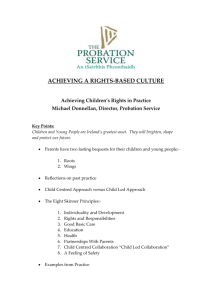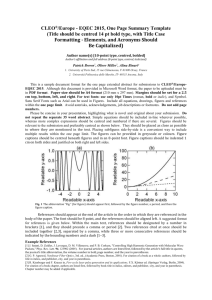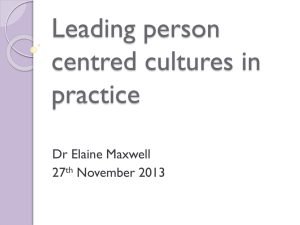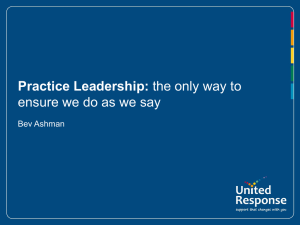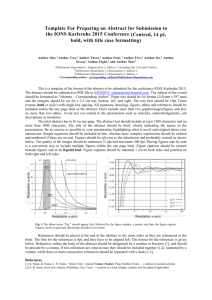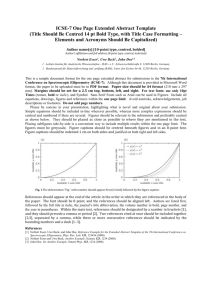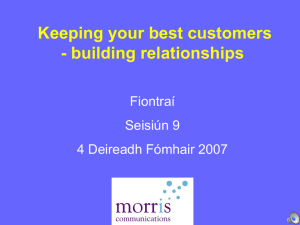PERSON CENTRED PLANNING: KEY FEATURES AND
advertisement
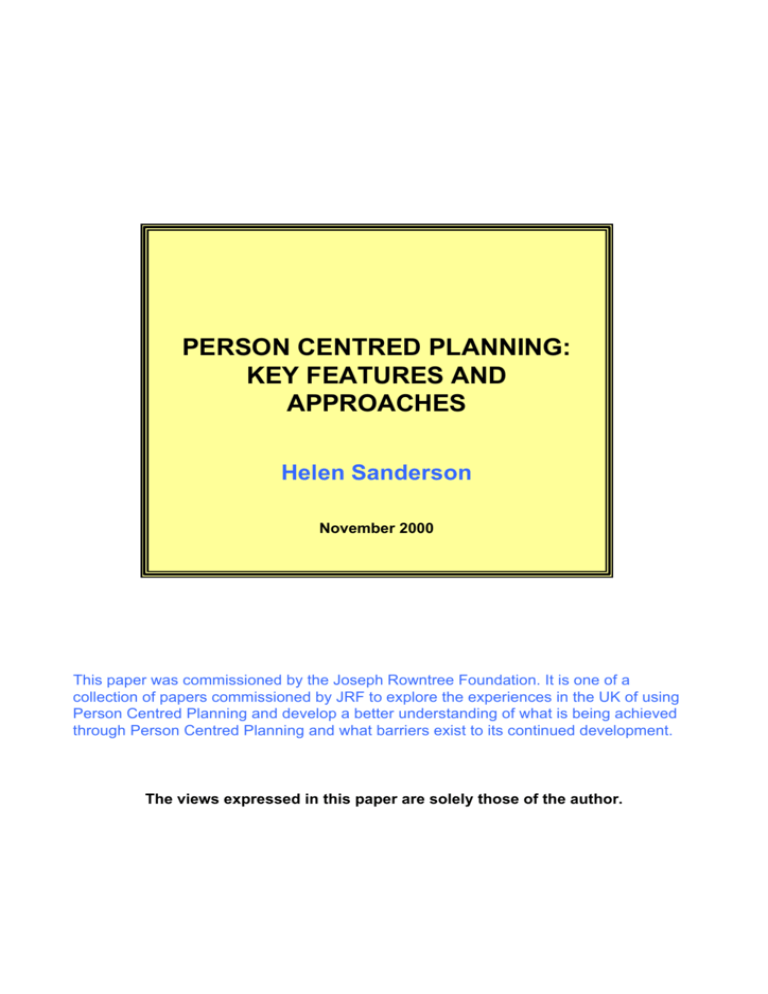
PERSON CENTRED PLANNING: KEY FEATURES AND APPROACHES Helen Sanderson November 2000 This paper was commissioned by the Joseph Rowntree Foundation. It is one of a collection of papers commissioned by JRF to explore the experiences in the UK of using Person Centred Planning and develop a better understanding of what is being achieved through Person Centred Planning and what barriers exist to its continued development. The views expressed in this paper are solely those of the author. PERSON CENTRED PLANNING: KEY FEATURES AND APPROACHES Helen Sanderson This paper defines person centred planning; identifies five key features that will be recognised in all approaches to person centred planning; suggests where different approaches may be useful; and introduces three issues that practitioners may have different views about. What is Person Centred Planning? We all think about, and plan our lives in different ways. Some people have very clear ideas about what they want and how to achieve it, others take opportunities as they arise. Some people dream and then see how they can match their dreams to reality. Sometimes it is useful to plan in a structured way, and person centred planning provides a family of approaches that can help do this. These approaches share common values and principles, and are used to answer two fundamental questions: • • Who are you, and who are we in your life? What can we do together to achieve a better life for you now, and in the future? Person centred planning is a process of continual listening, and learning; focussed on what is important to someone now, and for the future; and acting upon this in alliance with their family and friends. It is not simply a collection of new techniques for planning to replace Individual Programme Planning. It is based on a completely different way of seeing and working with people with disabilities, which is fundamentally about sharing power and community inclusion. Who uses it? Person centred planning is used by self-advocates, families, friends and paid support staff. When someone wants to think her life using person centred planning, they may have the energy and drive to ensure that her plan happens themselves. There are booklets that self-advocates can use themselves, or with some help. One is ‘Listen to me’, which is a way of someone recording what is important to them in their everyday life and what support they want to be able to do that. `Capacity Works` is another approach, which includes recording what someone hopes for the future. If the person does not want to, or for whatever reason is not able to, she may entrust this to a family member or a friend. This is what most of us do when planning changes in our own life. There are training courses for families to learn to plan with their son or daughter. There is a manual written specially for families learning to do person centred planning called, ‘Families Planning Together’. If the person does not have the stamina to organise the process, and has no one in her personal network that can take this on, she will have to rely on a member of staff. Using person centred planning within services presents a number of challenges for staff. Traditional Individual Programme Planning (IPP) required that staff behaved in a synchronised and standardised way. Person centred planning, requires that staff have a 2 flexible and responsive approach to meet peoples` changing circumstances, guided by the principles of good planning rather than a standard procedure. Staff need to be constantly problem solving in partnership with the person and their family and friends. Person centred planning is fundamentally different from traditional IPP. Therefore the qualities of facilitators and the expectations of them are different to those we have for people facilitating IPP’s. These include staff making plans in their own lives. ‘Practitioners need to feel the effects of these processes in their own lives, by making plans for themselves with their own circles of support, however those circles may be shaped. Practitioners owe it to the people they serve to personally exemplify courage in defining their own dreams and recruiting other’s support to pursue them. They also accept responsibility for making a continuing investment in improving their own understanding, knowledge and abilities as listeners, as facilitators, as organisers and as learners through reflection-in-action.’ John O’Brien In the UK, over the last few years most training courses have been for support staff. This is now slowly changing, as self-advocates, parents, and friends are being supported to learn how to use person centred planning. What is involved? Key features of person centred planning There are five key features of person centred planning. For many self- advocates, families and friends leading person centred planning, they will happen naturally. For example, if someone is organising their own planning, it will be difficult for them not to be at the centre, which is the first key feature of person centred planning! However, many people are dependent upon service systems and we need to struggle with the problems and dilemmas of sharing power in person centred planning. The following assumes that a member of staff is supporting someone to plan their life, and illustrates how for many of us person centred planning reflects a different way of thinking about people with disabilities, rather than a new technique. 1) The person is at the centre ‘Person centred planning begins when people decide to listen carefully and in ways that can strengthen the voice of people who have been or are at risk of being silenced.’ John O’Brien Person centred planning is rooted in the principles of shared power and selfdetermination. Power is an issue because many people are limited in their power in comparison to others. Others control their lives. They direct how people spend their time, what they eat, how they behave, even what they say. In this context, planning can become just a further indignity. Person centred planning can be used to redress this balance as far as possible. People using person centred planning make a conscious commitment to sharing power. Built into the process of person centred planning are a number of specific features designed to shift the locus of power and control towards the person. Where person centred planning is used within services, the following issues should be thoughtfully considered as ways of keeping the person is the centre, whilst remembering 3 that having meetings, involving the person and making the plan is not the outcome. The outcome is to help the person to get a better life on her own terms. • The person is consulted throughout the planning process If the person has been involved in planning before then it makes sense to talk to her about how she wants to plan, if she wants a meeting, and if so, what kind of meeting, and how she wants to be involved. If the person is new to planning, it is important to spend time with her explaining the purpose of planning and looking at different options. One way to help people think about planning is to work through the book ‘Our Plan for Planning‘ by Liverpool and Manchester People First. This booklet describes what people want before, during and after planning meetings. Where staff are involved in supporting planning, the booklet specifically describes what support people want from staff and what they do not want staff to do. • The person chooses who to involve in the process Unlike traditional models of planning, it is for the person to decide who she wants to include in the planning process, and how. This is easy to say, but within services this is highly counter-cultural to the way meetings are typically organised. If the people around the person cannot find a way to help her make and communicate that decision for herself, then they have to decide in good faith who they think the person would want to involve. A good starting-point is ‘people who know and care about the person’. This may well yield a different list from ‘people who provide a service to this person’. • The person chooses the setting and timing of meetings If a meeting does take place it is at a time convenient to the individual and those she wishes to invite and it is in a place where she feels at home. The planning is carried out in a way that is accessible to the individual as far as possible. Graphics, tapes, video or photos are often used. Using person centred planning involves finding creative ways to involve people whilst recognising that some people will have limited experience on which to base a choice and others will have limited ability to follow and contribute to the process. 1) Family members and friends are partners in planning ‘Person-centred planning celebrates, relies on, and finds its sober hope in people’s interdependence. At its core, it is a vehicle for people to make worthwhile, and sometimes life changing, promises to one another.’ John O’Brien Person centred planning puts people in the context of their family and their community. It is therefore not just the person themselves that we seek to share power with, but family, friends and other people from the community who the person has invited to become involved. These represent two of the most important challenges for services using person centred planning: how can we share power with the person and support them to participate as much as possible?, and how can we encourage and include family, friends and non-service people? Often it is family members who know the person best. They care about the person in a way that is different from everyone else and they will probably be involved in supporting the individual for the rest of their lives. They often bring huge commitment, energy and knowledge to the table. 4 Family members see the person and the situation from their own perspective. They may well have been let down time and again by services. They have probably had many experiences of not being heard unless they shout. They will probably have had professionals smile knowingly when they talk about their son or daughter and will have seen those professionals discount or ignore what they have to say. They will have had experience of being told nothing, of being passed from pillar to post. They will also have legitimate concerns about safety and security that have to be acknowledged, respected and addressed. Person centred planning starts from the assumption that families want to make a positive contribution and have the best interests of the person at heart, even if they understand those best interests differently from other people. In person centred planning, families are not caricatured as one dimensional - either ‘over-protective‘ or ‘not interested‘; instead they are invited to tell their side of the person‘s story with the richness of detail which can provide the clues for change. It is a crucial priority for services to sustain, values and strengthen peoples family connections. Sharing power with families means seeking their active involvement and building a partnership. This has to be based on families and professionals getting to know and trust each other. 3) The plan reflects what is important to the person, their capacities, and what support they require. Person centred planning seeks to develop a better, shared understanding of the person and her situation. A person centred plan will describe the balance between what is important to the person, their aspirations and the supports that they require. • Focus on capacities The focus of professional effort in the lives of disabled people has traditionally been on the person‘s impairment. People are channelled into different services depending on the category of their impairment, for example, learning difficulty, sensory impairment or loss of mobility. This leads to a process of assessment, which analyses and quantifies the impairment and its impact on the person‘s ability to undertake a range of tasks. This assessment results in a description of the person in terms of what she cannot do: her deficits. Professionals then set goals for people to try and overcome these deficits. The most serious consequence of this is that people‘s participation in ordinary community life is then seen as dependent on their success in achieving these goals. People are only given opportunities when staff feel they are ‘ready‘. They have to earn the right to be part of their own community. People who expected services to help them to manage their own lives have instead become trapped in a world where others make judgements about their future. Rather than this focus on deficits, person centred planning focuses on capacities and capabilities, on what people can do, who they are and what their gifts are. • Identifying supports Professionals have been training people towards `independence` for years. John O`Brien offers two definitions of independence. The first is the familiar rehabilitation model where people are trained to be able to meet their own basic needs with minimum assistance. The second is a `support model` which sees independence as choosing and living ones 5 own lifestyle - regardless of the amount and type of assistance necessary. Independence would therefore not be measured by the number of tasks which people can do without assistance but the quality of life a person can have with whatever support they need. Person centred planning assumes that people with disabilities are ready to do whatever they want as long as they are adequately supported. The ‘readiness model‘ is replaced with the ‘support model‘ which acknowledges that everyone needs support and some people need more support than others. Everybody in this world today needs support of one kind or another. People need support to go ahead and do things whether this support comes from a good friend, parents, a social worker, or guardian. There is no person so independent in the world that they don’t need anybody. We all need support, but with that support, we don’t want somebody coming in and taking over our lives. Michael J Kennedy A person centred plan clearly records what support someone requires, on her own terms. • A shared understanding – rethinking the role of the professional There are two common points of view about what people want and need. The first is that professionals know or can find out everything there is to know about people‘s needs. The other is that the person themselves knows everything there is to know about what they want. Neither of these is true. People using person centred planning assume that the person is the first authority on her life and that a dialogue with other people - family, friends, or service workers - can build on this. Therefore professionals are no longer in charge of collecting and holding information and making decisions about the person‘s life. Instead, individuals and the people who care about them take the lead in deciding what is important, which community opportunities should be taken or created and what the future could look like. In this style professionals move from being the `experts on the person` to being `experts in the process of problem solving with others`. People with disabilities need good expert advice, information and specific help from skilled professionals - not just nurses, doctors, therapists and social workers, but also lawyers, housing specialists and financial advisors. What they don‘t need is for those people‘s opinions to come first, to be the only basis for decision-making. In person centred planning clinical or professional staff move from being the owners of the process, centre-stage, to being backstage technicians, the people who know what is technically possible and how to make it happen. ‘Information gained from technical assessments of the person can be helpful, but only in the context of a knowledgeable account of a person’s history and desired future. Subordinating professional-technical information to personal-knowledge turns the typical agency decision making process on its head.’ John O`Brien and Herb Lovett • Discovering what is important to their person Person centred planning therefore focuses on the person’s capacities and not their deficits, and looks at what supports they need rather than assuming that people need to change. This shared understanding about the person will reflect what is important to the person in their day to day life, and in the future they desire. 6 4) The plan results in actions that are about life, not just services, and reflect what is possible, not just what is available. The focus of person centred planning is getting a shared commitment to action, and that these actions have a bias towards inclusion. By articulating the tension between what is important to the person and what is happening now, person centred planning creates a sense of urgency and a commitment to work for change. It opens up a space in which people can change what they think and do, from the small things they do to assist the person with everyday tasks to the big things they do to help the person have a better life. Person centred planning is not about standard service packages. Traditional planning has sought to fit people into existing service models and solutions, an available ‘bed‘ or a place in the day centre. Person centred planning describes the support needed from the perspective of the person, and then designs a unique arrangement for getting that support. People who practise person centred planning believe that communities also benefit from including people with disabilities. Communities which are more diverse and which create more opportunities for people to help each other directly are better places for everyone to live. Person centred planning challenges us to work actively to build more inclusive communities, not just provide better services. For most of us relationships are the basis of our lives. We fear rejection and isolation more than anything. We need to belong, to be a part of other people‘s lives and have them be a part of ours. Many people with disabilities end up spending time only with people who are paid to be with them. They have been segregated for so long that they have not had the chance to meet people with whom they have other things in common. Person centred planning seeks to help people create and maintain meaningful connections with people who are not paid to help them. Support staff who want to help people make these connections need to look outside the confines of services. Person centred planning asks ’how could we find someone who knows about this?‘ and recognises that the service world cannot meet, and should not seek to meet, a person‘s every need. It looks for respectful ways to strengthen people‘s connections with family, friends and community members. People who practise person centred planning have a bias towards inclusion. They will assume that the person wants to have friends, prefers freedom to captivity, wants somewhere decent to live, would like the chance to contribute, would rather be included in a community than excluded from it - unless the person clearly tells or shows them differently. 5) The plan results in ongoing listening, learning, and further action. ‘Person centred planning offers people who want to make change a forum for discovering shared images of a desirable future, negotiating conflicts, doing creative problem-solving, making and checking arrangements on action, refining direction while adapting action to changing situations, and offering one another mutual support.’ John O’Brien Person centred planning should not be a one off event. It assumes that people have futures; that their aspirations will change and grow with their experiences, and therefore the pattern of supports and services that are agreed now will not work forever. 7 Michael Smull describes planning as a promise to people. To fulfil this promise we need to reflect on successes and failures, try new things and learn from them and negotiate and resolve conflict together. Acknowledging and resolving conflict is important if people are to really work together to make change. Person centred planning is based on learning through shared action, about finding creative solutions rather than fitting people into boxes and about problem solving and working together over time to create change in the persons life, in the community and in organisations. What are the different approaches to person centred planning? There are several different approaches or styles of person centred planning. Each style is based on the same principles of person centred planning: all start with who the person is and end with specific actions to be taken. They differ in the way in which information is gathered and whether emphasis is on the detail of day to day life, or on dreaming and longer term plans for the future. It is not possible to provide detailed descriptions and examples of the different planning styles here, please refer to the reading and resources at the end. The common planning styles include Essential Lifestyle Planning, PATH and Maps, and Personal Futures Planning. Different styles of planning Each planning style combines a number of elements: a series of questions for getting to understand the person and her situation; a particular process for engaging people, bringing their contributions together and making decisions; and a distinctive role for the facilitator(s). PATH and MAPs focus strongly on a desirable future or dream and what it would take to move closer to that. Individual Service Design focuses on the past to help deepen the shared understanding and commitment to the person. Essential Lifestyle Planning and Personal Futures Planning gather information under more specific headings. Particular sections - such as the section in Essential Lifestyle Planning on how the person communicates and the section in Personal Futures Planning on local community resources - ensure that someone gathers together what is known and records this information so that everyone can use it. A skilled and experienced facilitator can adapt any style to cover all the areas in a person's life. People may need to focus on different areas of their lives at different times, and therefore use one planning style at one time and another at another time. We need to learn what is important to people on a day to day basis and about the future they desire. Sometimes it is important to learn about the day to day issues first, and then move on the learning about a desirable future. In other situations we need to hear about peoples dreams, and later learn about what it is important on a day to day basis. In considering what style to use facilitators need to consider the context and resources available to the person. Whether the person has a team to support her, or lots of friends and neighbours who want to get involved or a circle of support can influence the decision about which planning style to use. If the person has a team who do not know her very well, then starting with a planning style which invests a lot of time in really getting to know the person, for example Essential Lifestyle Planning or Personal Futures Planning, could 8 be a useful place to begin. If the person has family and friends or a circle who know and love her, then starting with dreams through PATH or Maps is useful. • When is Essential Lifestyle Planning useful? Michael Smull and Susan Burke-Harrison developed Essential Lifestyle Planning in the context of helping people move from long-stay institutions which were closing. Essential Lifestyle Planning is a very detailed planning style that focuses on the individual's life now and how that can be improved. It can help people find out who and what is important to the person and what support the person needs to have a good quality of life. It can help the person to get a life that makes more sense to her, now and tomorrow, and will certainly identify what is not working for her at present.. It does not address the individual's desirable future or dream, although this can be built in as an extra section. Essential Lifestyle Planning specifies the way that support is to be provided on a day to day basis, and this is helpful when different members of staff need to work consistently or when the person herself or the family is not able to give such detailed direction. Very little is known about some people who use services, particularly those who are moving out of an institution or who do not use words to communicate. Essential Lifestyle Planning is an excellent style to use as a start to getting to know someone and beginning to build a team around her. It can also provide a valuable safeguard when someone is moving from one setting to another, as it specifies the things that must happen for life to be at least tolerable. These can provide the basis for an individual service agreement between a purchaser and a provider agency. • When is PATH useful? Jack Pearpoint, Marsha Forest and John O’Brien developed PATH. It can be used as a planning style with individuals and with organisations. PATH is a very strongly focused planning style. It helps a group of people with a basic commitment to the person to sharpen their sense of a desirable future and to plan how to make progress. It assumes that the people present know and care about the individual and they are committed enough to support the person towards her desirable future over the next year. PATH is not a way of gathering information about a person, but a way of planning direct and immediate action. PATH focuses first on the dream and works back from a positive and possible future, mapping out the actions required along the way. It is very good for refocusing an existing team who are encountering problems or feeling stuck, and mapping out a change in direction. It requires either that the person can clearly describe their dream or, if she does not use words to speak, that the others present know her well enough to describe it for her. PATH needs a skilled facilitator to ensure that the dreams are those of the individual rather than those of the team. A PATH can only take place in a meeting. It depends on the momentum generated by a group of committed people. With a skilled facilitator, the meetings are powerful and often emotional, and people may make some profound changes in the way they see and understand the person. This then clears the way for specific actions to help the person make significant changes in her life. 9 • When is Maps useful? MAPs is a planning style developed by Judith Snow, Jack Pearpoint and Marsha Forest with support from John O‘Brien and others. It was used first as a tool for helping disabled children integrate into mainstream schools, but is now used more widely in person centred planning with children and adults. Maps is more of a picture building style than PATH. It can be used in a meeting or it is possible to use the individual components separately. For some people there are more important lessons to be learnt from looking at their past. Maps have a specific section at the beginning of the process for going over the history of an individual. It goes on to ask the question ’who is the person?‘ and ’what are their gifts?‘. Focusing on the gifts often provides the key to unlocking the community so Maps is a useful process when looking for ways of helping an individual to make connections. The Maps process allows people to express both their hopes for the future, in the dreaming section, and their fears about the future, in the nightmares section. The action plan is about working towards the dream and away from the nightmare. It treads a middle way between PATH and Essential Lifestyle Planning, allowing people to dream and including some ’getting to know you‘ in the process. It is neither as focused as PATH nor as detailed as Essential Lifestyle Planning. It can be used as a starting point with an individual who feels comfortable with dreaming and who already has a few people around her to support her to work towards her dreams. • When is Personal Futures Planning useful? Personal Futures Planning was developed by Beth Mount and John O‘Brien. Personal Futures Planning provides a way of helping to describe the person‘s life now and look at what they would like in the future. It helps people to build on areas of their life that are working well now and to move towards their desirable future. It is therefore useful when people need to learn more about the person's life (unlike PATH, which assumes this knowledge,) and to create a vision for the future (unlike Essential Lifestyle Planning that focuses on getting a lifestyle which works for the person now). It will not provide the detail about what the person requires on a day to day basis in the way that Essential Lifestyle Planning does, but provides an excellent overview from which areas of concern can be considered. The quality of the planning depends more on the skill of the facilitator than on choosing the ‘right‘ style. What are the different views on using person centred planning? Person centred planning is emerging from being something undertaken by a select few, to something accepted and encouraged by policies, and this presents new challenges and raises difficult issues. Practitioners of person centred planning generally have much more in common than they do differences, however, different views are emerging, for example: ‘Person centred planning should replace IPP and be used throughout all services’ Some people believe that person centred planning should be made available throughout services. 10 They suggest that ELP is used as the ‘default’ option, and used to replace IPP, and that other planning styles are added as required. Michael Smull developed ELP as a way of beginning person centred work for those whose lives are engulfed by services, (for example, in supported accommodation) to help people get the lifestyles that they want and to drive organisational change. He suggests that ELP is a useful starting point for person centred planning and that when people are getting what is important to them, person centred planning needs to extend to helping people describe and work towards their desirable future. This is not a ‘readiness’ approach, but a recognition that were someone cannot articulate their dreams, services often know so little about them, that they cannot possibly help someone to dream unless they can at first recognise what is important in their life. ‘Person centred planning should be primarily used with families and people who get the least from the service system’ Some people believe that service systems will inevitably pervert the possibilities of person centred planning and choose to work at the very edge of the service system, encouraging people to get out of, or avoid moving into the system. Some of the founders of different styles of person centred planning would be very concerned if a service tried to adopt that style of planning through a service (eg John O’Brien, Beth Mount). They believe that person centred planning should focus on those people who now get least from the system: those living with family members. They see person centred planning as a powerful support to families with disabled members at home and believe that focusing person centred planning on people already in some kind of residential service is another case of ignoring the many people who have only a little share of system resources. ‘Person centred planning cannot be truly effective without a circle of support’ People differ about the importance of convening an identified, ongoing support group for the focus person. Some see person centred planning as a means to the formation of a circle of support and believe that the circle matters much more than the planning process. Others believe that ideally everyone should have a circle of support, but that this is where we are moving towards with person centred planning and not the starting point. The starting point is supporting people to change their lives in ways that make sense to them, and we should be focussing on getting people good planning, and ensuring that services act on that. There is also some debate whether service providers can be full, effective members of support circles. Conclusion Person centred planning is defined in this paper as a process of continual listening, and learning; focussed on what is important to someone now, and for the future; and acting upon this in alliance with their family and friends. There are different approaches, however, good person centred planning is always recognisable because the person will be at the centre; working in partnership with family and friends, the plan will clearly identify what the person’s capacities are, what is important to her and what support she requires; there will be actions that have a bias towards inclusion, and the learning and reflecting are ongoing. 11 There are issues presented here to be debated and discussed, and ways forward to agree. It is vital that we do this, as person centred planning creates opportunities for us to change our lives and our relationships, to share power and listen in a deeper way, and discover to what inclusive communities are really about. Further information The information presented here is found in the book ‘People, Plans and Possibilities – exploring person centred planning (1997) by Helen Sanderson, Jo Kennedy, Pete Ritchie and Gill Goodwin. The book was based on the research supported by the Joseph Rowntree Foundation and is available from SHS, Edinburgh (tel. 0131538 7717). It contains detailed descriptions and examples of the approaches to planning mentioned in this paper. The quotes from John O’Brien are taken from ‘A little book on Person Centred Planning’ edited by John O’Brien and Connie Lyle O’Brien. Published by Inclusion Press, available from Inclusion Distribution (tel. 01625 859146). For information on the range of resources available on person centred planning see ‘Person Centred Planning – a resource guide’ by Helen Sanderson and Jackie Kilbane. Published by the North West Training and Development Team (tel. 0161 877 7499) www.nwtdt.u-net.com 12
